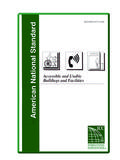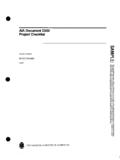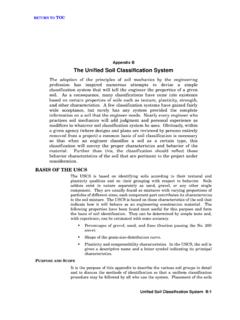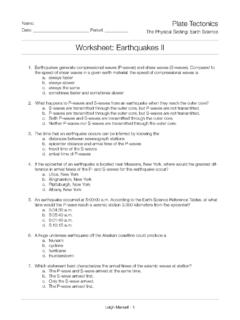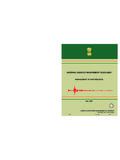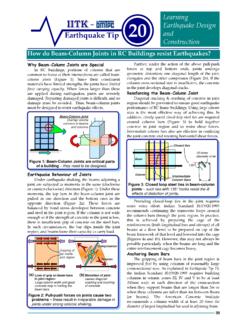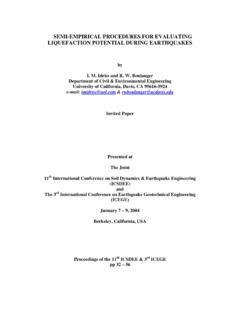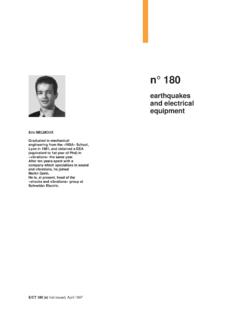Transcription of 14 FORCES— EARTHQUAKES - ARE Forum
1 14 LATERALFORCES EARTHQUAKESN omenclatureCanumerical coefficient used inEquation , given inUBC Table 16-QCvnumerical coefficient used inEquation , given inUBC Table 16-RCtnumerical coefficient for calcu-lating the period of vibrationFplateral force on part ofpoundsa structureor kipsFtthe portion ofVconsidered con-centrated at the top of thepoundsstructure in addition toFxor kipsFxlateral force applied to levelxpoundsor kipshntotal height of buildingfthxheight above base to levelxftIoccupancy importance factorIpimportance factor for elementsgiven in UBC Table 16-KRnumerical coefficient given inUBC Tables 16-N and 16-PSA soil profile typesSFgiven in UBC Table 16-JTfundamental period of vibration secVtotal design lateral
2 force orpoundsbase shearor kipswxthe portion ofWthat is located poundsat levelxor kipsWweightpoundsor kipsWpweight of a portion of apoundsstructureor kipsZseismic zone factor given inUBC Table 16-IAlthough a great deal has been learned about earth-quakes and their effects on buildings during the last50 years, seismic design is still an inexact science. Be-cause seismic design deals with dynamic forces ratherthan static forces, and because of the many variablesinvolved, it is often difficult to precisely predict the per-formance of a building in an earthquake and provide thebest possible design to resist the resulting lateral difficulty with seismic design is that the forcesproduced by an earthquake are so great that no buildingcan economically and reasonably be designed to com-pletely resist all loads in a major earthquake withoutdamage.
3 Building codes and analytical methods of de-sign are, therefore, a compromise between what couldresist all EARTHQUAKES and what is reasonable. Becauseof this, the current approach in designing earthquake -resistant structures is that they should first of all notcollapse during major seismic activity. Additionally, thecomponents of buildings should not cause other dam-age or personal injury even though they may be struc-turally damaged themselves. Finally, structures shouldbe able to withstand minor EARTHQUAKES without signif-icant analyatic methods of analysis and design of earth-quake-resistant structures are complex, even with thesimplified static analysis method allowed by the Uni-form Building Code (UBC).
4 However, a great deal ofresistance is provided by the basic configuration andstructural system of a building. The design of buildingsfor earthquake loads requires an early and close collab-oration between the architect and engineer to arrive atthe optimum structural design while still satisfying thefunctional and aesthetic needs of the chapter will discuss some of the basic principlesof EARTHQUAKES and the primary design and planningguidelines with which you should be familiar. In addi-tion, a basic review of the static analysis method will bePROFESSIONAL PUBLICATIONS, along with some simplified problems to helpexplain the design BASIC PRINCIPLESThe UBC provides for two methods of design for seis-mic forces: the static lateral force procedure and the dy-namic lateral force procedure.
5 The static method treatsthe seismic loads as equivalent lateral loads acting onthe various levels of the building. The total base shearis calculated and then distributed along the height ofthe building. The dynamic method uses a computer tomathematically model the building so the response ofthe structure can be studied at each moment in timeusing an actual or simulated earthquake dynamic method is very complex and its details arenot covered in the ARE The static method is reviewedin Section UBC is specific about which analysis method mayor must be used. In general, any structure may be, andcertain structures must be, designed using the dynamiclateral force procedures.
6 The static method may beused for the following types of structures. all structures in seismic zone 1 and in zone 2with occupancy category 4or 5, whether theyare regular or irregular regular structures using one of the lateral forceresistance systems listed in Table 16-N if theyare under 240 feet in height (see Table ) irregular structures not more than 5 stories or65 feet in height structures with a flexible upper portion support-ed on a rigid lower portion if all of the followingconditions are met: when both portions are considered separately,they can both be classified as regular the average story stiffness of the lower portionis at least ten times the average story stiffnessof the upper portion the period of the whole structure is no morethat times the period of the upper portionconsidered as a separate structure fixed at thebaseAll other structures must be designed using the Characteristics of EarthquakesEarthquakes are caused by the slippage of adjacentplates of the earth s crust and the subsequent releaseof energy in the form of ground waves.
7 Seismology isbased on the science of plate tectonics, which proposesthat the earth is composed of several very large platesof hard crust many miles thick, riding on a layer ofmolten rock closer to the earth s core. These plates areslowly moving relative to one another, and over timetremendous stress is built up by friction. Occasionallythe two plates slip, releasing the energy we know asearthquakes. One of the most well known boundariesbetween two plates occurs between the Pacific plate andthe North American plate along the coast of Califor-nia. EARTHQUAKES also occur in midplates, but the exactmechanism, other than fault slippage, is not fully plates slip where the stress is maximum, usuallyseveral miles below the surface of the earth.
8 Wherethis occurs is called thehypocenterof the term heard more often is theepicenter, which is thepoint on the earth s surface directly above the an earthquake occurs, complex actions are set result is the development of waves that ultimatelyproduce the shaking experienced in a building. Thereare three types of waves:Porpressurewaves,Sorshearwaves, andsurfacewaves. Pressure waves cause a rel-atively small movement in the direction of wave waves produce a sideways or up-and-down mo-tion that shakes the ground in three directions. Theseare the waves that cause the most damage to waves travel at or near the surface and can causeboth vertical and horizontal earth ground movement can be measured in three ways:by acceleration, velocity, and displacement.
9 All threeoccur over time, with most EARTHQUAKES lasting only afew seconds. It is the acceleration of the ground thatinduces forces on a interaction of the various waves and ground move-ment is complex. Not only does the earth move in threedirections, but each direction has a different, randomacceleration and amplitude. In addition, the movementreverses, creating a vibrating action. Even though thereis vertical movement, the UBC allows it to be neglectedunder certain types of seismic design. The weight ofa structure is usually enough to resist vertical is the side-to-side movement that causes the Measurement of EarthquakesEarthquake strength is commonly measured in twoways: with theRichterScaleand with theModifiedMercalliIntensityScale.
10 The Richter Scale measuresmagnitude as an indirect measure of released energybased on instrument recordings according to certainPROFESSIONAL PUBLICATIONS, EARTHQUAKES14-3defined procedures. The scale runs from zero at the lowend and is open at the upper end, although the largestearthquake ever recorded had a Richter magnitude scale is logarithmic, each whole number value onthe scale represents a tenfold increase in amplitude. Interms of energy released, each scale number representsabout 32 times the amount of energy below Modified Mercalli Intensity Scale is a measure ofan earthquake s intensity.
